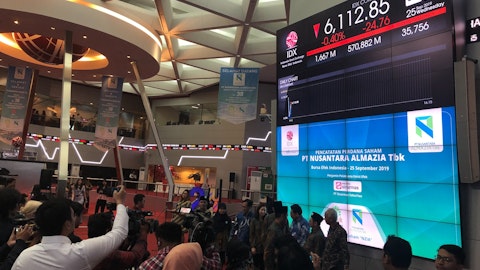CRA International, Inc. (NASDAQ:CRAI) Q3 2023 Earnings Call Transcript November 4, 2023
Operator: Good day, everyone, and welcome to Charles River Associates Third Quarter 2023 Conference Call. Please note that today’s call is being recorded. The company’s earnings release and Prepared Remarks from CRA’s Chief Financial Officer are posted on the Investor Relations Section of CRA’s website at www.crai.com. With us today are CRA’s President and Chief Executive Officer, Paul Maleh; Chief Financial Officer, Dan Mahoney; and Chief Corporate Development Officer, Chad Holmes. And at this time, I would like to turn the call over to Mr. Mahoney for his opening remarks. Thank you, Dan. Please go ahead.
Dan Mahoney : Thank you, John, and good morning everyone. Please note that the statements made during this conference call, including guidance on future revenue and non-GAAP EBITDA margin and any other statements concerning the future business, operating results or financial condition of CRA, including those statements using the terms ‘expect’, ‘outlook’ or similar terms are forward-looking statements as defined in Section 21 of the Exchange Act. Information contained in these forward-looking statements is based on management’s current expectations and is inherently uncertain. Actual performance and results may differ materially from those expressed or implied in these statements due to many important factors, including the level of demand for our services as a result of changes in general and industry-specific economic conditions.
Additional information regarding these factors is included in today’s release and in CRA’s periodic reports, including our most recently filed annual report on Form 10-K and quarterly reports on Form 10-Q filed with the SEC. CRA undertakes no obligation to update any forward-looking statements after the date of this call. Additionally, we will refer to some non-GAAP financial measures and certain measures presented on a constant currency basis on this call. Everyone is encouraged to refer to today’s release and related CFO remarks for reconciliations of these non-GAAP financial measures to their GAAP comparable measures and descriptions of the calculation of EBITDA and measures presented on a constant currency basis. I will now turn it over to Paul for his report.
Paul.
Paul Maleh: Thanks, Dan, and good morning everyone. Thank you for joining us today. Against a backdrop of macroeconomic uncertainties, we achieved $147.6 million in revenue in the third quarter, a decline of 0.6% relative to the third quarter of fiscal 2022. The lack of revenue growth for the company was an unusual departure from the prior two quarters in which CRA established new quarterly highs for revenue, as well as from CRA’s long history of delivering revenue growth and profit expansion. In each of the past five fiscal years, we have established new record highs in revenue, while our profitability measured by non-GAAP EBITDA, net income, and EPS increased at multiples of our revenue growth over the same period. The strength of the business and its ability to generate strong cash flows has allowed CRA to invest in value-creating growth and to return substantial capital to shareholders.
Our efforts have resulted in a balanced growth portfolio in terms of services offered, geography, and contributions from organic and inorganic pursuits. Moreover, our competitive position remains strong, and we see many growth opportunities resident in the markets we serve. As such, we will continue to execute on our plan with the objective of maximizing CRA’s long-term value per share. While our portfolio of services has demonstrated a history of exceptional performance, the third quarter of fiscal 2023 represented a speed bump on our journey. Utilization came in below historical levels at 66% due to two main factors, higher consultant headcount and lower new project originations. I will discuss both factors in greater detail. Similar to our experience in the first and second quarters of fiscal 2023, we continue to experience surprisingly low attrition rates.
As a consequence, our third quarter consultant headcount surged 11.3% year-over-year. Our year-to-date attrition in 2023 is historically low, falling even below the rates we experienced in 2020 when COVID-related lockdowns and economic uncertainty significantly limited employee movements. We are pleased with the team we have assembled, but we remain focused on balancing the supply of labor against the demand for our services. By the end of the year, we forecast consulting headcount to increase by mid to high single-digit percentage points year-over-year. Any further alignment, if necessary, will be realized through discipline management of hiring and attrition. On the demand side, our project lead flow has always served as a good barometer of future expansion in our business.
For example, during the period from fiscal 2018 through fiscal 2022, project lead flow grew by approximately 10% per year, while revenue grew by approximately 9% per year. For the third quarter of fiscal 2023, our projected lead flow increased by 10% year-over-year. This marks the fourth consecutive quarter of double-digit growth in CRA’s project lead flow. While the lead flow was strong during the third quarter, the conversion rates of those leads into new revenue-producing assignments continued to fall below expectations. As a result, during the third quarter, our new project originations declined 3% year-over-year. Based on an examination of lead composition, we see little evidence that we are losing projects more frequently to competitors.
Instead, it appears clients are delaying the start of new projects. We believe that project lead flow remains a good indicator of strong demand for our services in the long run, even if the conversion into projects is disrupted in the short term by economic uncertainty. Turning to results at the practice level, I was pleased that six of our 11 practices expanded year-over-year, and two of our largest practices, Forensic Services and Life Sciences, delivering double-digit revenue growth. We also generated double-digit revenue growth from our international operations. Our management consulting services grew 14.5% year-over-year, with our Energy and Life Sciences practices driving the expansion. In the third quarter, CRA’s Energy practice continued to support utilities, independent system operators, advanced energy technology companies, and investors on engagements emerging from the Energy transition.
For example, CRA is working with Bermuda Electric Company on its integrated resource plan, which will consider how the island could decarbonize away from fuel oil. For the utility Ameren Illinois, CRA recently completed an engagement to evaluate whether the company should trade and operate in a different wholesale market as a result of the Energy transition. Finally, an advanced nuclear reactor developer, CRA assisted the company’s leadership with the development of a commercialization strategy for North American power markets. Our Life Sciences work in strategy and policy consulting provides a unique perspective on competition issues in the Life Sciences industry. For example, in the third quarter, the practice assisted with the successful defense of Amgen’s acquisition of Horizon, a transaction that the FTC and some states had sued to prevent.
With respect to strategy consulting, we continue to perform considerable work in the areas of oncology, with more recent projects focused on the opportunity for antibody drug conjugates in the treatment of cancer. Revenue in the third quarter from CRA’s legal and regulatory services declined 5% against a backdrop of mixed trends within the legal market. Total case filings in the third quarter were up 15% year-over-year, while the number of court judgments declined 2% year-over-year. Within our legal regulatory services, four practices grew during the quarter. Our Forensic Services practice led the way in year-over-year revenue growth and was joined by the financial economics, intellectual property, and labor and employment practices. The Forensic Services practice continues to be called upon to leverage its deep digital and expert witness competencies to investigate various kinds of misconduct.
For example, on behalf of one of the world’s largest producers of electronic devices, we were retained to investigate, and one of our experts expects to testify regarding the alleged theft of confidential information by departing employees and related claims of spoliation of evidence. Driven in part by a resurgence in ransomware attacks, our Forensic Services practice is regularly called on to help investigate and remediate cyber incident response matters. In a number of cases, data was stolen not only from clients directly, but from third party service providers, such as file transfer services that had been marked as secure. Our client, who found themselves in precisely this situation, was a publicly traded leader in cloud-based human resources and payroll systems.

They called on CRA to help swiftly determine which of their hundreds of corporate clients had their data compromised, to identify which employees of those corporate clients needed to be notified and to assess whether the threat actor had left behind any backdoors that could potentially be exploited in the future. CRA’s intellectual property practice continues to advise on multiple high stakes litigation, arbitration, and valuation matters covering a broad range of industries, including cloud computing, consumer electronics, electric vehicles, software, financial services, and robotics. For example, a CRA expert provided economic analysis and testimony in a commercial arbitration between a major fast food chain and a provider of online ordering systems.
The practice has also seen an increase in work related to international trade commissions, investigations in which complainants seek to block the unlawful importation of products found to infringe U.S. intellectual property rights. CRA’s financial economics practice is working with the social media platform to analyze fairness risk for a range of machine learning predictive models used in marketing third party financial products to users. The analysis is assisting the client and its legal counsel in evaluating the risk of inadvertent discriminatory effects of the models. Similarly, CRA performed a fair lending analysis for a large bank across a range of consumer and small business portfolios. The analysis is directed at helping the client to understand and to monitor the risk of legal discrimination in the underwriting, pricing, and servicing of loans and helping the client to develop its internal capabilities to monitor failed lending risk on an ongoing basis.
The labor and employment practice continues to be a leading resource for clients facing complex employment issues and seeking proactive employment advice. During the third quarter, CRA experts were engaged across industries including finance, energy and leisure, as a critical partner for clients entering mediation and early case assessments on multiple California state wage and hour claims, Federal Fair Labor Standards Act Lawsuits, and Title VII discrimination claims. For example, the practice supported the expert testimony of Professor Jonathan Guryan, in a matter involving alleged adverse treatment with criminal background checks. Additionally, CRA experts are regularly retained to assist companies in auditing pay practices to ensure regulatory compliance, as well as internal pay equity, identifying potential payment corrections, and pay equity adjustments.
Finally, I would like to discuss CRA’s antitrust and competition economics practice, which remains the premier provider of merger and antitrust-related consulting services. After posting record quarterly revenue in each of the past two quarters and four of the past six quarters since the start of fiscal 2022, the practice was down slightly during the third quarter relative to year-ago period. This performance was consistent with the headwinds affecting the broader M&A landscape. Worldwide M&A activity totaled $2 trillion during the first nine months of 2023, a dramatic decrease of 27% compared to year-ago levels and the slowest first nine-month period for deal-making since 2013. The third quarter of 2023 decreased 16% compared with the second quarter of 2023 and marked the slowest third quarter for worldwide deal-making since 2012.
Turning to our full-year guidance, through the first three quarters of fiscal 2023, on a constant currency basis relative to fiscal 2022, CRA generated total revenue of $463.8 million and non-GAAP EBITDA of $50 million, achieving a margin of 10.8%. These results incorporate a constant currency adjustment, which contribute $1.4 million to revenue and $800,000 to EBITDA. Given our results to date and the lingering uncertainty across the broader market, we are reducing our revenue and profit guidance for the year. For full-year fiscal 2023, on a constant currency basis relative to fiscal 2022, we expect revenue in the range of $610 million to $620 million and non-GAAP EBITDA margin in the range of 10.3% to 10.7%. This updated guidance takes into account the market’s current expectations of future exchange rates for the U.S. dollar, which on a constant currency basis may shave $1.7 million from our reported revenue and approximately $300,000 from our reported EBITDA during the fourth quarter of fiscal 2023.
With that, I’ll turn the call over to Chad and then to Dan for a few additional comments. Chad?
Chad Holmes : Thanks, Paul. Hello, everyone. I want to update you on our capital deployment during the quarter. We concluded the quarter with $27.6 million of cash and $32 million of borrowings under our revolving credit facility, resulting in a net debt of $4.4 million. These figures reflect $48 million of payments during the quarter to reduce our borrowings under our revolving credit facility. The third quarter of 2023 also saw cash outlays for talent investments of $3.8 million. We spent $700,000 on capital expenditures, bringing our year-to-date total to $2 million. Demonstrating our confidence in the quality of the business and reflecting our commitment to return capital to shareholders, earlier today we announced a 17% increase in our quarterly cash dividend from $0.36 to $0.42 per common share.
This dividend will be payable on December 8, 2023 to shareholders of record as of November 28, 2023. Year-to-date, we have returned $31.4 million to our shareholders, consisting of $7.8 million of dividend payments and $23.6 million for share repurchases. We currently have $19.3 million available under our share repurchase program. With that, I’ll turn the call over to Dan for a few final comments. Dan?
Dan Mahoney : Thanks, Chad. As a reminder, more expansive commentary on our financial results is available on the investor relations section of our website under prepared CFO remarks. Before we get to questions, let me provide a few additional metrics related to our performance in the third quarter of fiscal 2023. In terms of consultant headcount, we ended the quarter at 1,014, consisting of 155 officers, 529 other senior staff, and 330 junior staff. This represents an 11.3% increase compared with the 911 consultant headcount reported at the end of Q3 fiscal 2022. Non-GAAP selling general and administrative expenses, excluding the 2.4% attributable to commissions to non-employee experts, was 16.5% of revenue for the third quarter of fiscal 2023, compared with 15.8% a year ago.
This quarter’s ratio was primarily impacted by an increase in travel and entertainment expenses and higher other operating expenses. The effective tax rate for the third quarter of fiscal 2023 on a non-GAAP basis was 18%, compared with 25.9% on a non-GAAP basis for the third quarter of fiscal 2022. The current quarter tax rate was positively impacted by the release of a reserve in a foreign jurisdiction. Turning to the balance sheet, DSO at the end of the third quarter was 114 days, compared with 115 days at the end of the second quarter of fiscal 2023. DSO in the third quarter consisted of 72 days of billed and 42 days of unbilled. We concluded the third quarter of fiscal 2023 with $27.6 million in cash and cash equivalents and a further $163.5 million of available capacity on our line of credit for total liquidity of $191.1 million.
That concludes our prepared remarks. Before we turn the call over for questions, Paul has one final announcement. Paul?
Paul Maleh: Thanks, Dan. Based on feedback from investors over the past year and questions regarding the markets in which we operate, we will host an Investor day on Wednesday, November 29, at the Fairmont Copley Plaza hotel in Boston to discuss its business, strategy and the industry trends in greater depth. We will have a number of colleagues joining us to highlight and provide more details on our practices, including Antitrust & Competition Economics, Forensic Services and Life Sciences. We will provide registration and webcast information soon and look forward to seeing many of you at this event. John, we would now like to open up the call for questions.
See also 11 Best Retail Stocks To Buy Now and 25 Largest Economies in the World by 2075.
Q&A Session
Follow Cra International Inc. (NASDAQ:CRAI)
Follow Cra International Inc. (NASDAQ:CRAI)
Operator: Thank you, sir. [Operator Instructions]. And the first question comes from the line of Andrew Nicholas with William Blair. Please proceed with your question.
Andrew Nicholas: Hi, guys. Good morning. I appreciate you taking my question.
Paul Maleh: Good morning.
Andrew Nicholas: I wanted to start with utilization. Bit of an aberration from your historical trends and down sequentially. Was hoping you could unpack that a little bit. I would imagine, you have some new grads that come in pressuring that utilization. You talked about some lower conversion rates, higher attrition. Is there any way, whether it’s qualitatively or quantitatively, to break that down a bit? And then relatedly, if you have any thoughts on the expected timeline for recovery to kind of the historical rates that you’ve shown in the low to mid-70s?
Paul Maleh: Sure. First of all, good morning, and thanks for the question, Andrew. We, throughout the year as we’ve commented, our attrition rates have been at historically low levels. Because of that, we have been slowly increasing our consulting headcount beyond what we initially expected at the beginning of the year. We have some excess capacity on the consulting side of the house, with or without the revenue slowdown that we experienced in Q3. But it is the type of excess capacity that we believe, through normal operating procedures at CRA, we could get on top of, say, sometime by the end of Q2 of fiscal 2024. So that will take care of itself. Clearly, if revenue materializes at a faster rate, that all moves up a bit, which we will all welcome.
But right now, given the head fake that I’ve had during Q1 of ‘23, of Q2 of ‘23, and now into the third quarter, I’m a little uncertain on how quickly normal revenue flows will materialize. So, I’m probably looking towards the middle of 2024 to get something I feel a bit more comfortable with, Andrew.
Andrew Nicholas: No, that’s super helpful. And understand that a lot of these things are difficult to predict that far out. I guess for my follow-up question, really strong growth internationally, which would obviously imply, a little bit slower growth domestically. I’m just kind of curious, is there anything – is it just lumpiness that would describe the differences by region, or is there anything going on in any of these end markets that would lead you to believe that international will continue to outperform U.S. or vice versa in the coming months and quarters? Thank you.
Paul Maleh: No, I don’t think there’s anything overriding that would say international should outperform North American operations going forward. We – as we began the third quarter of 2023, July was a really strong quarter. We were up about 6% company-wide. August gave us a bit of a head fake. It was a very soft quarter in which we saw existing matters, slow or have delays in the work. We saw new project opportunities not convert to new revenue-generating projects. In the month of August we saw an improvement in September, but not enough to offset that trough that we experienced in August. That slowness or that general trend existed across our portfolio, both across services and geographically.
Andrew Nicholas: And maybe that leads me to one last question, if I could sneak it in.
Paul Maleh: Sure.
Andrew Nicholas: Is your expectation for fourth quarter that it’s more like September, or is there some expectation of improvement or for it to look more like August? I’m just kind of trying to understand where we sit in terms of conservatism and guidance. Thanks Paul.
Paul Maleh: Yeah, given how accurate my expectations have been of late, no, we are expecting more of a September-looking month going forward than an August month. August, quite frankly, over the past decade, I haven’t seen many periods that encompassed everything we saw in the month of August. So, I think that’s an aberration, hopefully not famous last words. And so far, we were pleased with the improvement in the month of September, and we’re pleased with the way we began the fourth quarter.
Andrew Nicholas: Very helpful. Thank you again.
Paul Maleh: Thank you, Andrew.
Operator: And the next question comes from the line of Kevin Steinke with Barrington Research. Please proceed with your question.
Kevin Steinke : Good morning. I wanted to just start off by digging a little bit more into what changed since your last call that led to the changed revenue and margin outlook for the full year. It sounds like, perhaps the conversion rate into new projects was less than you might have expected, and you attrition was lower than you expected. Is that – are those the two main contributing factors to the change in the outlook?
Paul Maleh: First of all, good morning, Kevin. The attrition, we saw it coming, right. We’ve been talking about low attrition rates throughout fiscal 2023. So the fact that they didn’t reverse course in the third quarter was not as much of a surprise, but still resulted in excess consulting capacity. What was generally a surprise is the drop of our conversion of new business opportunities to revenue generating projects. If I compare the conversion rates that we were enjoying throughout the history of CRA, we were down about 20% on those conversions on that. So we weren’t getting any new projects coming in. New projects are essential, particularly to try to get our new consulting staff busy on a more expeditious manner. So, it was the conversion that I think led the disappointing results.
Kevin Steinke : Okay, understood. And your comments about August and September, that implies then that the conversion rate has picked up a bit in September. Is that correct?
Paul Maleh: The conversion rate in September, in the first few weeks we have in October has improved from what we observed in August. But I think it’s important to also note is still below, say our experiences over the last decade, excluding 2023. They are just operating at a lower level, and with no clear explanation from our part as to why that’s happening. We are not entering in to new markets. We are not trying to introduce ourselves to new client bases. They are the same services that we have always offered, and for the most part with the same people. So the kind of drop in the conversion rate is frustrating, but we’re riding that storm. And even with that kind of volatility, nine months into this year, we’re still up 4% on revenue.
The profitability levels are near our historic highs that we achieved in 2021 and 2022. So it could be worse, but by all means Kevin, we’re a bit frustrated, with where the revenue came out, particularly with the head fake that we experienced in the month of August.
Kevin Steinke : Okay, that’s fair. So that’s interesting, because that kind of leads into my next question. You mentioned that there’s no real clear explanation for the slowdown in conversion rates. I think you might’ve mentioned that it’s fairly broad based across practices and geographies, is that correct? And then you haven’t been able to tie it to anything like perhaps, M&A transactions being delayed or maybe that’s a part of it. But no, no clear trends or themes behind the conversion rate slowdown, I guess.



